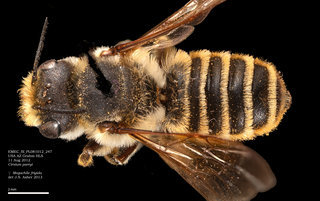
David Cappaert · 8
Megachile frigida, female, dorsal, EMEC SI PL |

Click on map for details about points.
|
80x5 -
240x3 -
240x4 -
320x1 -
320x2 -
320x3 -
640x1 -
640x2
Set display option above.
Click on
images to enlarge. |
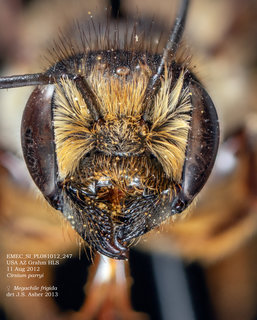
David Cappaert · 8
Megachile frigida, female, head, EMEC SI PL |
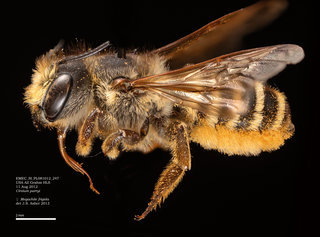
David Cappaert · 8
Megachile frigida, female, lateral, EMEC SI PL |
|
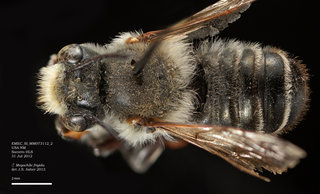
David Cappaert · 8
Megachile frigida, male, dorsal, EMEC SI MM |
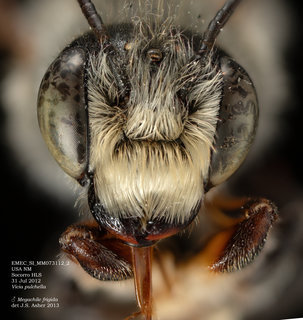
David Cappaert · 8
Megachile frigida, male, head, EMEC SI MM |
|
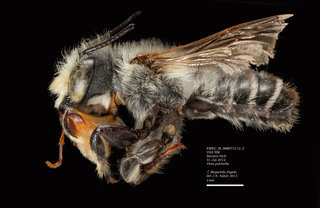
David Cappaert · 8
Megachile frigida, male, lateral, EMEC SI MM |
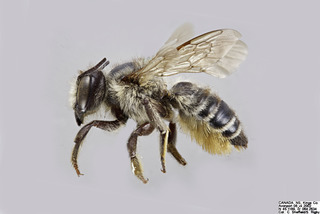
© Copyright Laurence Packer 2014
· 7
Megachile frigida FEM comp |
|
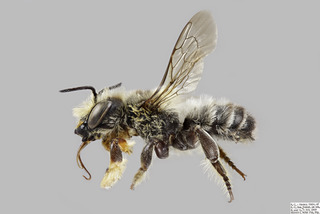
© Copyright Laurence Packer 2014
· 7
Megachile frigida MALE f |
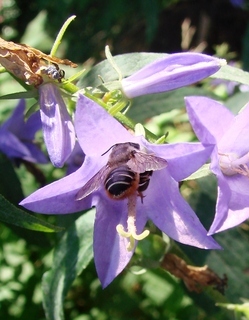
© Copyright John Ascher, 2006-2014
· 6
Megachile frigida, Frigid Leaf-cutter Bee |
|
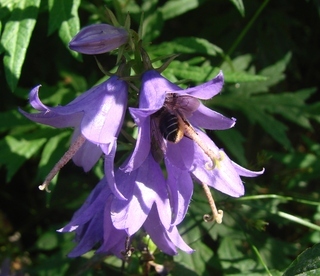
© Copyright John Ascher, 2006-2014
· 6
Megachile frigida, Frigid Leaf-cutter Bee |
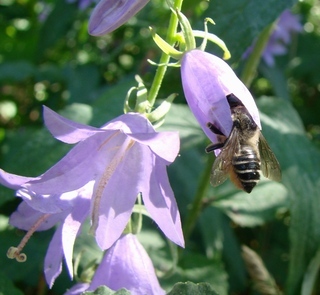
© Copyright John Ascher, 2006-2014
· 6
Megachile frigida, Frigid Leaf-cutter Bee |
|
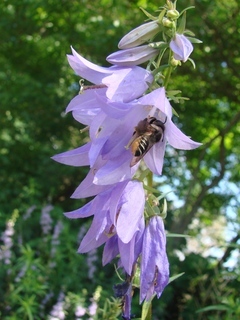
© Copyright John Ascher, 2006-2014
· 6
Megachile frigida, Frigid Leaf-cutter Bee |
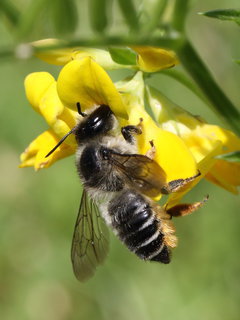
© Copyright Micheal Veit 2010
· 6
Megachile frigida, f on Lotus -- |
|
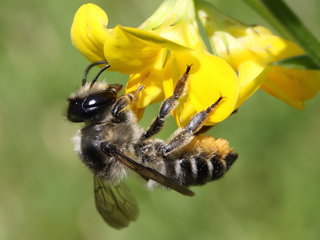
© Copyright Micheal Veit 2010
· 6
Megachile frigida, f on Lotus -- |
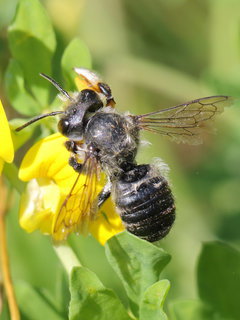
© Copyright Micheal Veit 2010
· 6
Megachile frigida, m on Lotus -- |
|
Overview |
Reprinted with permission from: Mitchell, T.B. 1962 Bees of the Eastern United States. North Carolina Agricultural Experiment Station Technical Bulletin No. 152.
Megachile frigida frigida
FEMALE — Length 12-15 mm.; entirely black, including tegulae and legs, spurs testaceous; eyes subparallel; clypeal margin very shallowly incurved, the narrow median area very slightly produced, narrowly shining and imp unctate; mandibles 4-dentate, inner toothbroadly truncate (fig. 43); lateral
equally distant from eyes and margin of vertex; cheeks considerably wider than eyes; punctures of vertex relatively coarse and distinct, quite close medially, becoming well separated laterally between eyes and ocelli, cheeks minutely and quite closely punctate throughout; face below ocelli rather densely rugoso-punctate, becoming very finely so on sides of face, supraclypeal area more or less shining medially, punctures minute and vague, becoming close and rather deep laterally, elypeus with a median, impunctate line, punctures quite close and deep on each side; pubescence yellowish-white and rather copious around antennae and over lower half of face, on cheeks below, and on thorax laterally and posteriorly, vertex with more or less fuscous, erect pubescence, a quite dense line of erect fuscous hairs above anterior ocellus and below lateral ocelli; scutum and scutellum with extensive areas of erect, fuscous hairs, scutum rather narrowly pale pubescent anteriorly; punctures of scutum and scutellum quite deep and distinct, close in large part, slightly separated only in center of scutum, close throughout on scutellum and fine and densely crowded on axillae; pleura rather dull, punctures very close, rather coarse below, becoming fine and densely crowded above; propodeum somewhat smoother and more shining, with only very vague and minute punctures evident; hind basitarsi somewhat narrower and shorter than their tibiae, fore and mid basitarsi much shorter than their tibiae; tegulae shining, with close, minute punctures; wings subhyaline, veins brownish-testaceous; terga 2-4 shallowly grooved across base, basal margin of grooves only very slightly carinate, tergum 5 with only a subcarinate basal impression, apical margins of terga rather narrowly and slightly depressed laterally, these whitish fasciate laterally, completely so on 4 and 5, discal pubescence of 1 and 2 copious, erect and entirely pale, 3-5 with conspicuous, erect and rather elongate blackish pubescence; punctures of terga minute, slightly separated medially, becoming slightly coarser laterally on the more apical plates; tergum 6 about straight in profile, with abundant, rather short, erect, black pubescence and with rather dense, subappressed, fuscous hairs; sternum 6 rather well covered with yellowish hairs, these becoming somewhat more sparse toward apex which is densely fringed with short dark hairs; scopa otherwise golden yellow, the more basal sterna, very closely and finely punctate, becoming somewhat more coarse and sparse toward apex, apical margins of each plate rather narrowly yellowish-hyaline, fasciae not evident.
MALE — Length 11-15 mm.; black, tegulaetestaceous, spurs yellow
large part yellow; clypeal margin beneath beard nearly straight, slightly crenulate medially; mandibles distinctly 4-dentate, upper margin quite strongly flexed, lower margin somewhat angulate medially, margin straight from this to tip of basal, acute, inferior process; apical segment of flagellum quite broadly dilated; lateral ocelli subequally distant from eyes and margin of vertex; cheeks very much broader than eyes, inferior margin with an acute, robust tubercle just beneath base of mandible, and a pair of slightly oblique lines of dense, pale pubescence just above; punctures of vertex very fine and densely crowded medially, becoming slightly more coarse and distinct laterally, minute and densely crowded on cheeks, somewhat more coarsely rugosopunctate below ocelli, but very fine and densely crowded beneath pubescence on clypeus, supraclypeal area and sides of face; pubescence copious, yellowish and very dense around antennae and lower half of face, supraclypeal hairs directed upward, clypeal hairs outward and downward; cheeks with very short and rather sparse pale hairs, these becoming more erect and elongate on vertex; thorax with yellowish-white hairs laterally and posteriorly, dorsum with somewhat more copious, elongate, pale yellowish hairs, with no evident dark admixture; punctures of scutum, scutellum, axillae and pleura very fine and densely crowded, propodeum somewhat smoother, with only close, minute and vague punctures evident; front coxal spines narrow and much elongated, pubescent posteriorly only at base, coxa with a dense, patch of ferruginous setae at base of the spine, and dense, creamy pubescence laterally, the surface yellow; front tarsi broadly dilated and deeply excavated, entirely yellow, conspicuously broader than tibiae, with a broad, yellowish, posterior fringe; tibiae rather narrowly yellow at apex, otherwise fuscous on outer surface; posterior margin of femora fuscous, sharply carinate above, but otherwise largely pale yellow or testaceous, subcarinate below, lower surface toward base with a pair of conspicuous, longitudinal, brownish, integumental stripes, conspicuously fringed posteriorly toward base; mid and hind tarsi relatively short and narrow, but little modified, mid tarsi densely pale tomentose, hind tarsi with an elongate, prominant, anterior fringe; tegulae somewhat shining, very minutely and closely punctate; wing subhyaline, veins brownishtestaceous; terga 2-4 shallowly grooved across base, apical margins depressed laterally, with pale, apical fasciae at sides of 2 and 3, and a complete one on 4, 1 and 2 and base of 3 with copious, elongate, erect, pale yellowish pubescence, 4 and 5 and apex of 3 with largely fuscous pubescence; punctures fine and quiteclose but not crowded throughout; tergum 5 only inconspicuously fasciate apically, if at all; tergum 6 shining, very finely or minutely, closely punctate, carina rather low and not very broad, with a rather shallow, median, emargination, subentire on each side, median teeth of apical margin rather broadly carinate, somewhat nearer to each other than to lateral angles, lateral teeth not evident; tergum 7 acute medially, barely evident; sterna 1-4 exposed, surface shining, with exceedingly minute and hardly evident punctures, apical margins rather narrowly depressed and yellowishhyaline, largely bare; setose area of sternum 5 short but quite broad, setae fine and short (fig. 44); sternum 6 with rather narrow, transverse, densely setose areas that nearly meet medially, apical lobe well developed, slightly produced medially, lateral angles narrowly produced and acute; gonocoxites gradually narrowed above base, slightly dilated and sinuate above, with a low, subapical, ventral protuberance, the apex narrowly produced (fig. 45).
DISTRIBUTION—Alaska to Newfoundland, south to Arizona, Michigan and Pennsylvania, June to August.
FLOWER RECORDS—Apoeynum, Astragalus, Campanula, Epilobium, Malvastrum, Medicago, Melilotus, Monarda, Pentstemon, Rosa, Trifolium, Verbena and Vicia.
Megachile frigida appalachensis
This occurs in the southern Appalachians and differs from typical frigida in both sexes in the entire absence of the abdominal fasciae. It possibly averages slightly larger than the typical form.
DISTRIBUTION—New York, down the Appalachians to Georgia, June to September.
FLOWER RECORDS—Apocynum, Baptisia, Coreopsis, Galax, Koellia, Pent stemon, Rhododendron, and Vernonia.
|
|
|
Identification | |
Extracted from: Sheffield C. S., et al (2011). Leaf cutter and Mason Bees of the Genus Megachile Latreille (Hymenoptera; Megachilidae) in Canada and Alaska. Canadian Journal of Arthropod Identification No. 18
Megachile (Xanthosarus) frigida Smith, 1853
Megachile frigida Smith, 1853. Cat. Hym. Brit. Mus. 1: 193 (♂).
Megachile monardarum Cockerell, 1900. Ann. Mag. Nat. Hist. (7) 6: 11 (♀).
Megachile (Delomegachile) vidua var. appalachensis Mitchell, 1935b. Trans. Amer. Entomol. Soc. 61: 205 (♀, ♂).
Megachile (Delomegachile) frigida appalachensis Mitchell, 1962. North Carolina Agricult. Exper. Stat. Tech. Bull. 152: 134.
Diagnosis. The female of M. frigida is distinct and can be recognized by the broadly truncate inner mandibular tooth. The male of M. frigida is distinct and can be recognized by the combination of the front legs, which are pale and broadly expanded with two longitudinal brown bars on the yellowish anterior side of the front femur, and the prominent carina on the mesopleura just below and behind wing base, the carina concave and scoop-like ventrally with a yellowish-hyaline rim.
FEMALE: Length 12-15 mm.
Head. 1) compound eyes subparallel; lateral ocelli equally distant from eyes and margin of vertex, 2) clypeal margin very shallowly incurved, the narrow median area very slightly produced, narrowly shining and impunctate, 3) mandibles 4-dentate, with incomplete cutting edges between the 2nd and 3rd and 3rd and 4th teeth, 4th tooth broadly truncate (Plate 1, Figure M34), 4) gena considerably wider than compound eye (4:3), 5) punctures of vertex relatively coarse and distinct, quite close medially, becoming well separated laterally between eyes and ocelli, gena minutely and quite closely punctate throughout; frons densely rugosopunctate, becoming very finely so on paraocular area, supraclypeal area more or less shining medially, punctures minute and vague, becoming close and rather deep laterally, clypeus with a median, impunctate line, punctures quite close and deep on each side, 6) pubescence yellowish-white and rather copious around antennae and over lower half of face, on gena below, vertex with brownish, erect pubescence, a quite dense line of erect brown hairs above anterior ocellus and below lateral ocelli, 7) F1 about as long as broad, and slightly longer than pedicel and F2, which is slightly broader than long (2.5:2), remaining flagellomeres longer than broad (3:2), apical flagellomere more elongate (4:2).
Mesosoma. 1) pubescence yellowish-white and rather copious laterally and posteriorly, mesoscutum and scutellum with extensive areas of erect, brown hairs, mesoscutum rather narrowly pale pubescent anteriorly, 2) punctures of mesoscutum and scutellum quite deep and distinct, close in large part, slightly separated only in centre of mesoscutum, close throughout on scutellum and fine and densely crowded on axilla; pleura rather dull, punctures very close, rather coarse below, becoming fine and densely crowded above; propodeum somewhat smoother and more shining, with only very vague and minute punctures, triangle somewhat shiny and impunctate, 3) hind basitarsus somewhat narrower and shorter than its tibia, fore and mid basitarsi much shorter than their tibiae, spurs yellowish-brown, 4) tegula shining, with minute punctures separated by > 1 pd, 5) wings subhyaline, veins brown.Metasoma. 1) T2-T4 shallowly grooved across base, basal margin of grooves only very slightly carinate, T5 with only a subcarinate basal impression, apical margins of terga rather narrowly and slightly depressed laterally, with whitish fasciae laterally, fasciae entire on T4 and T5, discal pubescence of T1 and T2 copious, erect and entirely pale, T3-T5 with conspicuous, erect and rather elongate blackish pubescence; punctures of terga minute, slightly separated medially, becoming slightly coarser laterally on the more apical terga; T6 nearly straight in profile, with abundant, rather short, erect, black pubescence and with rather dense, subappressed, brown hairs, 2) S6 rather well covered with yellowish hairs, these becoming somewhat more sparse toward apex, which is densely fringed with short dark hairs; scopa otherwise golden yellow, the more basal sterna very closely and finely punctate, the punctures becoming somewhat more coarse and sparse toward apex, apical margins of each sterna rather narrowly yellowish-hyaline.
MALE: Length 11-15 mm.
Head. 1) compound eyes subparallel; lateral ocelli subequally distant from eyes and margin of vertex, 2) clypeal margin nearly straight, slightly crenulate medially, 3) mandibles distinctly 4-dentate, with upper margin quite strongly flexed, lower margin somewhat angulate medially, margin straight from this to tip of acute lower process, which is basal in position, outer edge of mandibles brownish, 4) gena much broader than compound eye (8:5), lower margin with an acute, robust tubercle just below base of mandible, 5) punctures of vertex very fine and densely crowded medially, becoming slightly more coarse and distinct laterally, minute and densely crowded on gena, somewhat more coarsely rugosopunctate on frons, but very fine and densely crowded beneath pubescence on clypeus, supraclypeal area and paraocular area, 6) pubescence copious, yellowish and very dense around antennae and lower half of face, supraclypeal hairs directed upward, clypeal hairs outward and downward; gena with very short and rather sparse pale hairs, and a pair of slightly oblique lines of dense, white pubescence just above tubercle, pubescence becoming more erect and elongate on vertex, 7) F1 about as long as broad, just slightly longer than pedicel, and shorter than remaining flagellomeres, which are slightly longer than broad (3:2.5), apical flagellomere almost twice as long as preceding segment and quite broadly dilated.
Mesosoma. 1) pubescence yellowish-white laterally and posteriorly, dorsal surface with somewhat more copious, elongate, pale yellowish hairs, with no evident dark admixture , 2) punctures of mesoscutum, scutellum, axilla and pleura very fine and densely crowded, propodeum somewhat smoother, with close, minute and vague punctures, triangle shiny and impunctate; mesopleura with a prominent carina with a yellowish-hyaline rim just below and behind wing base, carina concave and scoop-like ventrally, 3) front coxal spine narrow and elongated, pubescent posteriorly only at base of spine, coxa with a dense patch of reddish setae at base of spine, and dense, white pubescence laterally; front tarsus broadly dilated and deeply excavated, entirely yellow, conspicuously broader than tibia, with a broad, yellowish, posterior fringe; tibia rather narrowly yellow at apex, otherwise brownish on outer surface; posterior margin of front femur brown, sharply carinate above but otherwise largely pale yellowish-brown and subcarinate below, lower surface toward base with a pair of conspicuous, longitudinal, brownish, integumental stripes, conspicuously fringed posteriorly with longer hairs toward base; mid and hind tarsi relatively short and narrow, mid tarsi densely pale tomentose, hind tarsi with an elongate, prominent, anterior fringe, spurs yellow in large part, 4) tegula yellowish-brown, somewhat shining, very minutely and closely punctate, 5) wing subhyaline, veins brownish-black.
Metasoma. 1) T2-T4 shallowly grooved across base but not carinate; apical margins depressed laterally, with pale, apical fasciae at sides of T2 and T3, and a complete one on T4, T5 at most inconspicuously fasciate apically; T1 and T2 and base of T3 with copious, elongate, erect, pale yellowish pubescence, T4-T6 and apex of T3 with largely brownish pubescence; punctures fine and quite close but not crowded throughout; T6 shining, very finely or minutely, closely punctate, carina rather low and not very broad, with a rather shallow but wide median, emargination, entire on each side; median teeth of apical margin rather broadly carinate, somewhat nearer to each other than to lateral angles, lateral teeth not evident; T7 acute medially, barely evident, 2) S1-S4 exposed, the surface shining, with exceedingly minute and fine punctures, apical margins rather narrowly depressed and yellowish-hyaline, largely bare.
Genitalia. Plate 2, Figure G34.
Discussion. Megachile frigida is a common species. It excavates nests into rotting logs (Stephen 1956) but also accepts trap-nests (Jenkins and Matthews 2004) (Table 1). Details of nesting biology and architecture are provided by Stephen (1956) and Jenkins and Matthews (2004).
|
|
|
Names | |
|
|
| Supported by | |
Updated: 2024-04-16 21:54:04 gmt
|